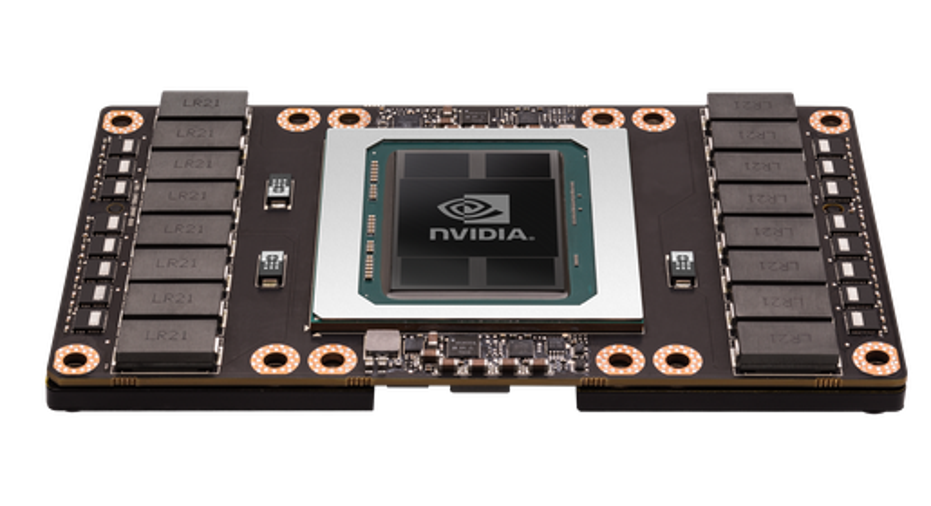NVIDIA GPUs Are Powering Some Big Clouds

NVIDIA's (NASDAQ: NVDA) data center segment grew 145% in fiscal 2017 to $830 million as growth in applications of deep learning and cloud computing fueled demand for NVIDIA's graphics processing units (GPUs).
So, what is driving the usage of data centers and cloud computing?
It's all about big data
NVIDIA's Tesla P100 GPU accelerator for data centers. IMAGE SOURCE: NVIDIA INC.
The world is racking up huge amounts of data. Every day, we create a 2.5 quintillion bytes of data from social media posts, photos, videos, transaction records, and the list goes on and on. It's estimated that 90% of the data in the world has been created in just the past two years.
It's not just the data you see on the surface, either, like a tweet or an online video. There is data that piles up behind the scenes to help businesses understand customer activity. In addition, scientists and medical professionals rack up huge amounts of data from sensors and images. Self-driving cars will create a whole new smorgasbord of data from maps, cameras, weather detection equipment, and sensors.
The faster we can gather insights from this data, the greater the speed with which businesses and organizations can create breakthrough new ideas and innovate.
Unlike the central processing units (CPUs) used to open and close applications on PCs, the GPU can handle multiple parallel processing tasks simultaneously, allowing large amounts of data to be processed much faster.
What is known as GPU-accelerated computing has brought to reality the idea of deep learning -- an advanced form of artificial intelligence. Deep learning allows a computer to process all of the data we generate and learn from it without human input. The power of GPUs applied to deep learning is reducing each learning cycle of a computer to days, instead of weeks or months.
The explosion of cloud computing
Major technology companies like Baidu, Alphabet, and Facebookwere among the first to use GPUs for deep learning. But there are also many start-up businesses and organizations that would like access to a data center for the application of deep learning with GPUs, except it's too costly.
The solution from cloud providers has been to put a data center in the cloud. So far, partnerships with many of the largest technology companies in the world are positioning NVIDIA as the GPU provider of choice for cloud computing.
NVIDIA is selling GPUs to the biggest cloud providers out there, including Microsoft's (NASDAQ: MSFT)Azure, Amazon.com's Amazon Web Services (AWS), Alphabet's Google Cloud Platform,International Business Machines, and Tencent Holdings. These companies are providing very fast GPU-powered cloud computing for a much lower cost than the large capital investment it would otherwise require. As a result, start-up businesses will be able to act on innovative new ideas in a way that was out of reach in the past.
Microsoft and NVIDIA
The partnership with Microsoft might be the most important one for the graphics specialist.
In March 2017, NVIDIA and Microsoft announced the HGX-1 hyperscale GPU accelerator to power AI cloud computing. According to the companies, the HGX-1 is 100 times faster than a CPU-based deep learning system and provides cost savings of up to 20% for implementing AI training.
The HGX-1 uses NVIDIA's NVLink technology to allow companies to customize the right ratio of CPUs and GPUs for a specific task. NVIDIA and Microsoft are labeling the HGX-1 as the new architectural standard for cloud computing.
The HGX-1 is part of Microsoft's Project Olympus initiative to create a standardized open-source hardware architecture for cloud providers to build data centers around. Microsoft and NVIDIA are hoping that by making it simpler and easier to configure a data center around a standard design, the market for cloud computing can accelerate even faster.
Intel and Microsoft's partnership in the 1990s created the ATX standard configuration for PC motherboards, causing a boom in demand forIntelCPUs. Intel still dominates the CPU market.
If the same thing happens with respect to the HGX-1 for cloud computing, it could further accelerate demand for AI cloud computing, with NVIDIA holding a position as the dominant chip provider.
The market opportunity is growing fast
There are different cloud computing markets, but the onefueling NVIDIA's data center segment is the market for cloud system infrastructure services (IaaS), such as Amazon's AWS or Microsoft Azure. The IaaS market is expected to grow from $25 billion in 2016 to $71 billion by 2020, according to Gartner.
NVIDIA is becoming more deeply entrenched in this booming market with every partnership win. As the IaaS market continues to grow, demand for NVIDIA's GPUs should grow along with it.
Find out why Nvidia is one of the 10 best stocks to buy nowMotley Fool co-founders Tom and David Gardner have spent more than a decade beating the market. (In fact, the newsletter they run, Motley Fool Stock Advisor, has tripled the market!*)
Tom and David just revealed their 10 top stock picks for investors to buy right now. Nvidia is on the list -- but there are nine others you may be overlooking.
Click here to get access to the full list!
*Stock Advisor returns as of April 3, 2017.
Suzanne Frey, an executive at Alphabet, is a member of The Motley Fools board of directors. Teresa Kersten is an employee of LinkedIn and is a member of The Motley Fools board of directors. LinkedIn is owned by Microsoft. John Ballard owns shares of Nvidia. The Motley Fool owns shares of and recommends Alphabet (A shares), Alphabet (C shares), Amazon, Baidu, Facebook, Gartner, and Nvidia. The Motley Fool has a disclosure policy.